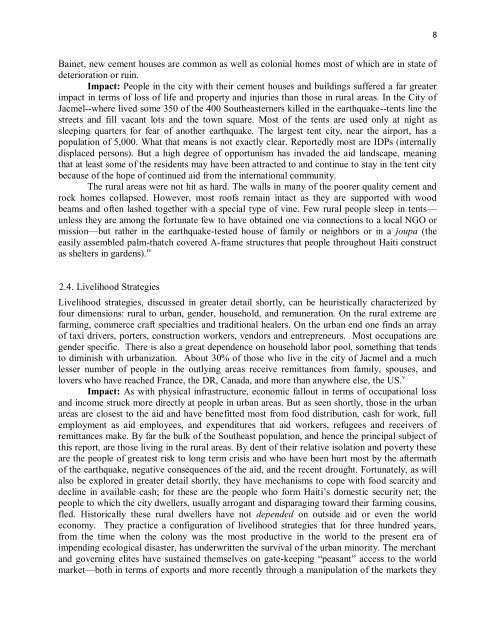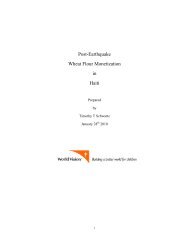Post Earthquake Jacmel (Haiti) Report and EMMA
Create successful ePaper yourself
Turn your PDF publications into a flip-book with our unique Google optimized e-Paper software.
8<br />
Bainet, new cement houses are common as well as colonial homes most of which are in state of<br />
deterioration or ruin.<br />
Impact: People in the city with their cement houses <strong>and</strong> buildings suffered a far greater<br />
impact in terms of loss of life <strong>and</strong> property <strong>and</strong> injuries than those in rural areas. In the City of<br />
<strong>Jacmel</strong>--where lived some 350 of the 400 Southeasterners killed in the earthquake--tents line the<br />
streets <strong>and</strong> fill vacant lots <strong>and</strong> the town square. Most of the tents are used only at night as<br />
sleeping quarters for fear of another earthquake. The largest tent city, near the airport, has a<br />
population of 5,000. What that means is not exactly clear. <strong>Report</strong>edly most are IDPs (internally<br />
displaced persons). But a high degree of opportunism has invaded the aid l<strong>and</strong>scape, meaning<br />
that at least some of the residents may have been attracted to <strong>and</strong> continue to stay in the tent city<br />
because of the hope of continued aid from the international community.<br />
The rural areas were not hit as hard. The walls in many of the poorer quality cement <strong>and</strong><br />
rock homes collapsed. However, most roofs remain intact as they are supported with wood<br />
beams <strong>and</strong> often lashed together with a special type of vine. Few rural people sleep in tents—<br />
unless they are among the fortunate few to have obtained one via connections to a local NGO or<br />
mission—but rather in the earthquake-tested house of family or neighbors or in a joupa (the<br />
easily assembled palm-thatch covered A-frame structures that people throughout <strong>Haiti</strong> construct<br />
as shelters in gardens). iv<br />
2.4. Livelihood Strategies<br />
Livelihood strategies, discussed in greater detail shortly, can be heuristically characterized by<br />
four dimensions: rural to urban, gender, household, <strong>and</strong> remuneration. On the rural extreme are<br />
farming, commerce craft specialties <strong>and</strong> traditional healers. On the urban end one finds an array<br />
of taxi drivers, porters, construction workers, vendors <strong>and</strong> entrepreneurs. Most occupations are<br />
gender specific. There is also a great dependence on household labor pool, something that tends<br />
to diminish with urbanization. About 30% of those who live in the city of <strong>Jacmel</strong> <strong>and</strong> a much<br />
lesser number of people in the outlying areas receive remittances from family, spouses, <strong>and</strong><br />
lovers who have reached France, the DR, Canada, <strong>and</strong> more than anywhere else, the US. v<br />
Impact: As with physical infrastructure, economic fallout in terms of occupational loss<br />
<strong>and</strong> income struck more directly at people in urban areas. But as seen shortly, those in the urban<br />
areas are closest to the aid <strong>and</strong> have benefitted most from food distribution, cash for work, full<br />
employment as aid employees, <strong>and</strong> expenditures that aid workers, refugees <strong>and</strong> receivers of<br />
remittances make. By far the bulk of the Southeast population, <strong>and</strong> hence the principal subject of<br />
this report, are those living in the rural areas. By dent of their relative isolation <strong>and</strong> poverty these<br />
are the people of greatest risk to long term crisis <strong>and</strong> who have been hurt most by the aftermath<br />
of the earthquake, negative consequences of the aid, <strong>and</strong> the recent drought. Fortunately, as will<br />
also be explored in greater detail shortly, they have mechanisms to cope with food scarcity <strong>and</strong><br />
decline in available cash; for these are the people who form <strong>Haiti</strong>‘s domestic security net; the<br />
people to which the city dwellers, usually arrogant <strong>and</strong> disparaging toward their farming cousins,<br />
fled. Historically these rural dwellers have not depended on outside aid or even the world<br />
economy. They practice a configuration of livelihood strategies that for three hundred years,<br />
from the time when the colony was the most productive in the world to the present era of<br />
impending ecological disaster, has underwritten the survival of the urban minority. The merchant<br />
<strong>and</strong> governing elites have sustained themselves on gate-keeping ―peasant‖ access to the world<br />
market—both in terms of exports <strong>and</strong> more recently through a manipulation of the markets they
















